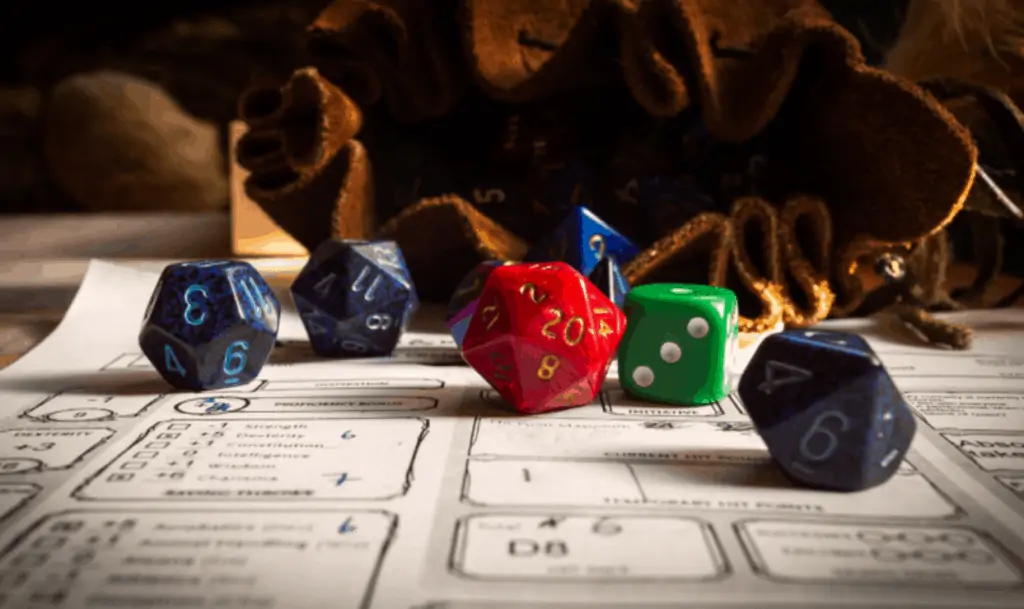The most common combat spell used by the usually supporting cleric Guiding Bolt does damage and gives allies an advantage during combat.
While it is often ignored, it could be one of the most strategically effective spells to use that you can use.
The rules of Guiding Bolt are found in The Players Handbook on page 248.
Guiding Bolt 5e
Evocation: 1st Level
Casting Time: 1 Action
Range: 120 feet
Components: V, S
Duration: 1 Round
A light-colored flash streaks towards a creature of your preference within your range. Use a ranged spell on the targeted.
If you hit the target, the target is hit with 4d6 damage from the radiant, and the next roll you make against the target before the close of the next turn will benefit due to the mysterious flickering light at the target up to the point of.
At higher levels: If the spell is cast with an unused slot for spells of 2nd level or greater, the damage increases by 1d6 for every level higher than.
The rules of Guiding Bolt tell us a few things. The spell is designed to be used in combat It is effective in dealing damage for a spell at 1st level and can be improved.
Furthermore, it comes with the benefit of providing allies with a greater chance to be hit, so it’s a reliable support spell too.
Is Guiding Bolt Good?

Guiding Bolt is a level 1 spell that deals 4d6 damage.
So it’s definitely a good spell. The fact that it can be increased in power as the character advances makes it a useful tool during the course of level progression.
The advantage granted upon the next attack against the target is quite powerful when combined with a sneak attack from a rogue or a melee ally that has devastating critical.
Its ability to do amazing damage is just the cherry on the cake.
There are a few drawbacks with Guiding Bolt, though. In the first place, it’s included in the Cleric spell list, which means that using it means that there is one less space to heal.
The other issue with it is that it needs an attack that is ranged.
The typical cleric is the highest level of wisdom and maybe even strength, however, the ability to move is usually lower on the list. Clerics usually focus on having armored bodies to increase their armor class (AC).
Guiding Bolt was initially only on the list of spells for clerics however, with the introduction of other source materials it’s now available to Glory Paladin, Divine Soul Sorcerer, Celestial Warlock, as well as members of the Boros Guild (Ravnica).
There are a few spells that beat Guiding Bolt at first level and even higher. The radiant damage is amazing and isn’t the most commonly used resistance.
This is a spell that could enable a cleric to alter what happens in a battle within a single casting.
Does Guiding Bolt Need Sight?
The spell does not define “a target you can see” as the only one you select within a certain range.
The rules for making attacks are that attacks made against an unobserved target (via invisibility or darkness) are done at an advantage.
This does not permit you to target corners or under full cover. However, the spell requires a straight route to the desired target.
Guiding Bolt may be the best chance a cleric has at knocking out punches or at least set up to use one. Its damage output is very high and it could knock a strong opponent out after the fight.
Another possibility is that an opponent who is defeated will still be able to benefit from the next attack which gives it a greater chance of winning a critical.
Utilizing the spell near the final battle point is crucial because it takes away healing spell slots.
When Should Guiding Bolt Be Used?
If you want to use a guiding bolt as a knockout blow, you should use it on higher-level enemies near the middle or end of a fight.
If the spell’s high damage at any level isn’t enough to kill your enemies, the advantage from your next attack surely will.
This also keeps you from wasting your healing slots because the fight will end that much faster.
Also, make sure to use the spell when your allies can use their own abilities, like a Paladin’s “Smite” or a Rogue’s “Sneak Attack.”
The advantage only lasts until your next turn, so the spell is useless if your allies need to move a turn to attack the enemy.
Guidance Bolt is optimized for support in Combat
It’s been reported by the media that Guiding Bolt has standalone damage output.
Making sure that the spell is optimized to maximize its use of it during combat is what makes it more powerful.
It’s not making much sense to apply it to minion-type enemies of low level, keep the slot machines. Instead, focus the spell on the biggest bad guys when they appear.
Likely, the DM will not create a major bad that could be a one-shot using this spell. This means that you need to support your spell.
Examine the order of initiative and you will be able to create your next ally to make a difference.
It may require some time and planning, but it’s well worth the effort.
To maximize the value for your buck, you should cast the spell at a time when you could get the paladin to come in with a smite or have the rogue unleash an attack that sneaks in.
If this is your plan, there may not be a need to boost the spell, since the benefit of the attack is available by the spell’s base stage of casting.
There is a case for never recasting Guiding Bolt. Because spells can be critically damaged the target on a normal 20 Guiding Bolt does 8d6 damage.
It is comparable to the damage of a Fireball Spell. Plus it has the benefit.
If the order to initiate is not working for you If you are unable to take action, stop your actions.
This will let you decide when the spell will go off. It could be activated by an event that is specific to you, for example, if the enemy makes an attack.
Is The Spell Overpowered?
Some players think that this spell is a little too strong because it does 4d6 damage, can give advantage on anything, and can be upcast at higher levels.
With this spell, clerics can do a lot of damage to bosses and minibosses, making combat in 5e less fun for the other players.
You could stop the spell from working, but you could also use it to help your cleric. Every time they get the spell ready to use at the start of the adventuring day, they give up a healing slot.
If they use the spell every time they get a chance, they aren’t focused on healing the group either.
You can try to make up for this by giving your party more encounters during the adventuring day.
This forces your cleric to use their spell load in a strategic way, rather than just throwing out all their spells and then either taking a short break or using cantrips for the rest of the dungeon. You can also say that the spell sometimes doesn’t work.
It’s a ranged attack roll, and sometimes the enemy’s AC is too high to handle the magic. The bolt could be avoided or stopped with a ward or other piece of armour.
If your cleric keeps missing when using the guiding bolt at higher levels, that also means that spell slots are being used up.
It really depends on the cleric player and the DM, but the spell is not too strong in the right hands.
Make Monsters Tougher
When it comes to monsters and encounters, there’s nothing that says you have to follow the rules. If your cleric uses the spell strategically when it makes sense to do so, you should reward the player by making the monsters they fight more difficult.
Use steel golems instead of iron golems if they are scraping iron golems. Make them fight a bugbear boss or war chief if they have a rack of bugbear skulls on the mantle.
To keep fights interesting, you can even make new versions of old monsters with new weapons and attacks.
Just make sure that you’re not making the fight harder for the cleric at the expense of your other heroes.
Adding new monsters and attacks can be fun, but because of the CR system, you might want to playtest or talk to other DMs before changing stats.
Final Words
Guiding Bolt must be prepared by all classes that can prepare it. It is a fantastic combination of support and damage which is a rare combination that is available in games.
It’s accessible as a level 1 spell that has no limit on the number of times you can cast it.
It’s frustrating when it casts and fails however when it does hit the target, it’s oh so delightful.
The cleric is one of the most flexible classes available in the game when it comes to the many domains available.
There’s no reason to think of yourself as a healer any longer and spells like Guiding Bolt really emphasize that fact.
FAQs
How Do I Roleplay Guiding Bolt?
If you want to be a good roleplayer in guiding bolt, you should look at the god your character worships. All holy magic is a reflection of the god your character prays to. If your character follows Moradin, the god of dwarven battle and honour, your guiding bolt could be a magical hammer that flies towards the target and showers them with light.
If your character worships Auril, the winter goddess, the guiding bolt could be a beam of frost that leaves a thin layer of frost on the character it hits. Also, if you upcast the spells using a different spell slot, don’t just say “I’m casting Guiding Bolt at 3rd level.” Instead, describe how the beam of frost is much colder, thicker, and stronger than usual, or how the mythical hammer is much, much bigger.
It’s mostly for flavour, but it can be a lot of fun to make your spells look different and make them all about your god. What makes 5e D&D so fun is that each character can be changed and made unique. Plus, it lets other people role-play, and it makes D&D (and combat in particular) something you can use to make a story, instead of having to stop the story to roll some dice.
Not every player will want to do that, but it can be fun for combat in a group that likes to tell stories.
Does Guiding Bolt Scale Well?
Yes, it does, and it scales very well into the late game, especially if you upcast it. This spell is a real gem that every cleric should use because it does more damage, gives a free advantage, and can both help and hurt.
Even if you don’t want to deal damage and instead want to heal or buff the rest of the party, you can still use these spells every now and then. You will be fine as long as it doesn’t keep missing when it comes to repeated attacks. Also, if you roll enough attacks, your spell will hit something.
Is Guiding Bolt Better Than Inflict Pain?
Inflect Pain is a level one necromancy spell that lawful evil or just plain evil clerics can use to make their enemies feel pain. What it does is: When you use Inflict Pain, your hand gets a dull red glow that lets you send blindingly hot pinpricks through the body of your target.
This does 2d6 points of nonlethal damage plus 1 point per caster level (up to +5), and the target takes a -1 penalty to attack rolls, skill checks, and ability checks for 1 minute. If you make a successful saving throw, the damage is cut in half and the penalty goes away.
Well, guiding bolt is pretty good because inflict pain only lets you do non-lethal damage and gives the target a negative effect for 10 rounds or a minute of combat.
But the extra damage from your caster level is capped at +5 and can’t be increased. If the target makes a successful Constitution saving throw, they can reduce the damage by half and avoid the penalty. Most clerics don’t have a choice between these two spells, but if you do, you should choose the guiding bolt because it lasts the whole game.









